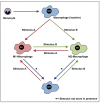Macrophages: From Simple Phagocyte to an Integrative Regulatory Cell for Inflammation and Tissue Regeneration-A Review of the Literature
- PMID: 36672212
- PMCID: PMC9856654
- DOI: 10.3390/cells12020276
Macrophages: From Simple Phagocyte to an Integrative Regulatory Cell for Inflammation and Tissue Regeneration-A Review of the Literature
Abstract
The understanding of macrophages and their pathophysiological role has dramatically changed within the last decades. Macrophages represent a very interesting cell type with regard to biomaterial-based tissue engineering and regeneration. In this context, macrophages play a crucial role in the biocompatibility and degradation of implanted biomaterials. Furthermore, a better understanding of the functionality of macrophages opens perspectives for potential guidance and modulation to turn inflammation into regeneration. Such knowledge may help to improve not only the biocompatibility of scaffold materials but also the integration, maturation, and preservation of scaffold-cell constructs or induce regeneration. Nowadays, macrophages are classified into two subpopulations, the classically activated macrophages (M1 macrophages) with pro-inflammatory properties and the alternatively activated macrophages (M2 macrophages) with anti-inflammatory properties. The present narrative review gives an overview of the different functions of macrophages and summarizes the recent state of knowledge regarding different types of macrophages and their functions, with special emphasis on tissue engineering and tissue regeneration.
Keywords: M1-macrophages; M2-macrophages; biomaterials; inflammation; macrophage; monocytes; plasticity; tissue regeneration.
Conflict of interest statement
The authors declare no conflict of interest.
Figures








References
Publication types
MeSH terms
Substances
LinkOut - more resources
Full Text Sources

